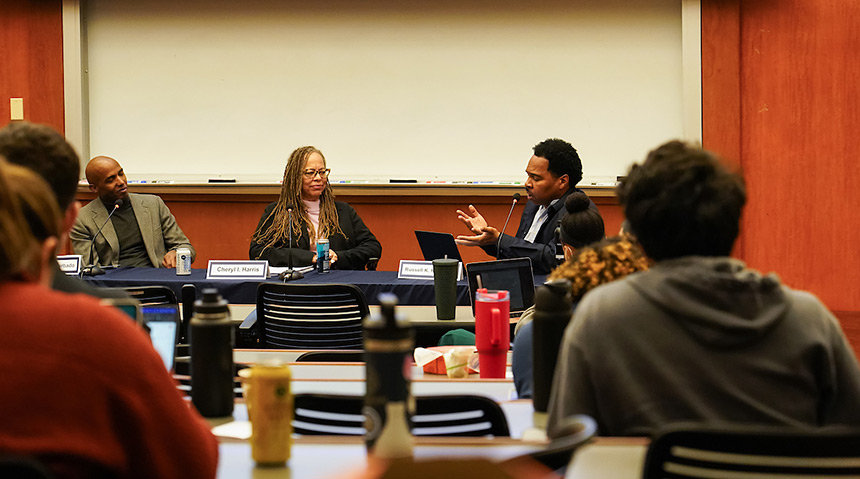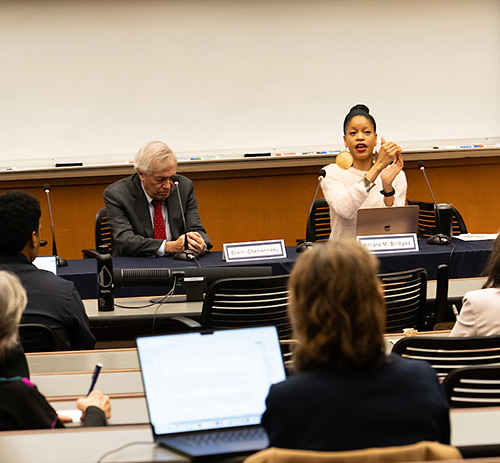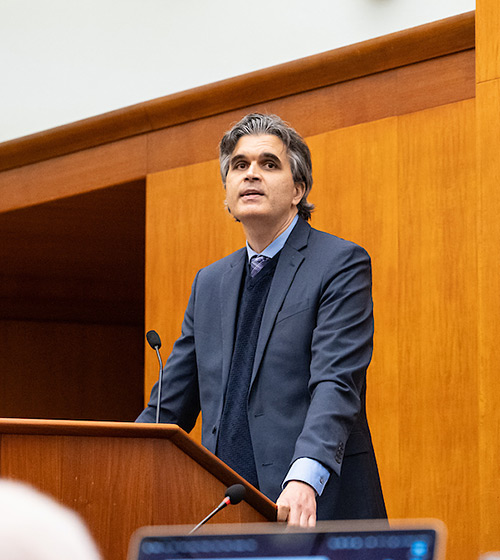
By Andrew Cohen
It seems the spotlight has never beamed more brightly on the United States Supreme Court, with legal experts pointing to recent high-profile decisions they say departed from precedent, veered toward right-wing ideology, and threatened equal treatment under the law.
At the California Law Review March symposium, organized by its student leaders with Berkeley Law Professors Jonathan D. Glater and Russell K. Robinson, scholars from across the country confronted the Court’s rulings, justifications, and implications.
“Over the past couple years, we’ve seen a truly stunning array of breaks from historical precedent that have been harmful to minority and vulnerable groups,” Glater said.

Professor Khiara M. Bridges discussed the foreword that she published in the November 2022 Harvard Law Review issue about the court’s October 2021 term. Her article analyzes a wide range of cases across many different areas of constitutional law and concludes that the conservative supermajority on the court has a theory of racism.
“The Court believes that racism against people of color today takes the same form that racism took in the pre-civil rights days,” she said. “The Court will provide people of color relief from a racially burdensome law only if the Court sees a resemblance between the challenged law and the racism of yesteryear.
“The result is that the Court provides relief to people of color solely when the racism embedded in the challenged law or policy is so closely tied to white supremacy that it would be embarrassing for the Court to do nothing. This permits the Court to do no more than the absolute bare minimum and, in so doing, to preserve a modicum of whatever legitimacy it has managed to retain.”
Bridges argued that the Court’s “impoverished understanding of what constitutes racism” is a strategy that functions to preserve society’s racial hierarchy.
Renowned constitutional law scholar and Berkeley Law Dean Erwin Chemerinsky said proper interpretation of the Equal Protection clause hasn’t driven the Court’s decisions, but that “what’s motivating this Court is following the conservative agenda, not legal principles.”
Unpacking how various opinions can’t viably be explained by originalism, he noted that one in three Black children today are born below the poverty line and that disproportionate treatment across the criminal justice system calls for action the Court has yet to take.
“Every study shows that people of color are more likely to be stopped, arrested, prosecuted, convicted, and given larger sentences than whites involved in the exact same behavior,” he said. “Yet the Supreme Court has shown no inclination to deal with racist policing at all, and has done nothing to address qualified immunity following George Floyd’s death.”
Chemerinsky said recent decisions open the door to additional discrimination, and detour from the Court’s past ethos that “stopping discrimination is more important than protecting the freedom to discriminate.”
Court inaction
Decrying a “democracy deficit in the state context,” Berkeley Law Professor Kathryn Abrams pointed to citizens’ growing inability to hold elected officials accountable to majority preferences and highlighted the divide between public opinion and state action on reproductive rights.
“State legislatures have been able to enact abortion restrictions despite their lack of support from those these elected officials represent,” she said. And where pro-abortion forces have fought back by using the initiative process to amend the state constitution, Abrams added that state officials have thrown up a host of obstacles, which may “damage the use of direct democracy [and] … breed cynicism about state governance.”
Discussing his new book Before the Movement: The Hidden History of Black Civil Rights, Professor Dylan Penningroth said “the Court has been misusing history since the 1856 Dred Scott decision,” and that “many of its recent decisions related to race carry the deeply distorted notion that race is marginal to American law and matters only in the Constitution and within criminal justice.”
A panel on intersectionality examined the Court’s role in furthering institutional inequality across various sectors of society by discussing recent rulings on reproductive rights, affirmative action, and LGBTQ rights.
“If the Court overrules or weakens the due process precedents that protect reproductive and LGBTQ rights, it’s going to silently gut a fair amount of the equal protection law that’s been constructed over the past few decades to protect oppressed groups,” said UCLA Law Professor Cary Franklin.
Yale Law Professor Monica Bell said Justice Clarence Thomas misguidedly frames Black complaints about racial inequity as resigning to a sense of victimhood: “In part what he’s saying here is that racial justice and the freedom he is seeking means obliviousness to the structural and statistical facts of racial inequality that shed light on the discrimination these people are experiencing.”

Berkeley Law Professor Seth Davis delved into the Court’s jurisprudence about Native nations, and the revival of concerns first raised by presidential candidate Barry Goldwater in the 1960s — that the 1964 Civil Rights Act was creating “tyranny” in the name of minority rights with the broad power the Court had given to federal agencies and their fact-finding.
“Today, Goldwater’s heirs say the same things about bureaucratic rights,” Davis said. “Goldwater lost the election, but paved the way to President Reagan’s election in 1980. His judicial appointees chipped away at administrative rights and the New Deal settlement that strengthened them and Donald Trump’s judicial appointees have done more than chipping away, they’re hacking away.”
The Supreme Court last year in Haaland v. Brackeen upheld the Indian Child Welfare Act — which in part restricts the removal of Native children from their families and establishes a preference that those removed be placed with extended family members or Native foster homes — as consistent with congressional powers and not in violation of the Tenth Amendment’s anti-commandeering principles.
“It’s a fair question whether shrinking the administrative state would be good for tribal sovereignty, as federal administrative power could threaten Indian nations,” Davis said.
Moderator and fellow Berkeley Law Professor Leti Volpp said the panel sought to track doctrinal developments across different contexts, noting that “as scholars we tend to work in segmented silos” and that the symposium sought to help “enable us to see what isn’t readily visible.”